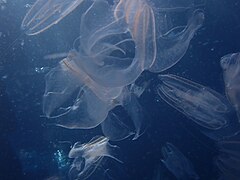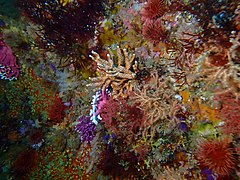The dive site Alphard Banks is an offshore rocky seamount on the Agulhas Bank, about 40 nautical miles south of Cape Infanta near Struisbaai in the Western Cape province of South Africa.
Understand
editAlphard Banks is the southernmost recreational dive site on the continental shelf of Africa.
Position
edit- 1 Alphard West Pinnacle: S35° 02.395' E20° 51.856' (16 m)
This site is in the Agulhas Bank Complex Marine Protected Area (2019). A permit is required.
Name
edit"Alphard" is the name of the brightest star in the constellation of Hydra, the banks are indirectly named for this star, possibly via a ship of the same name.
Depth
editMaximum depth is about 80 m. and the top of the Western pinnacle is about 16 m. Average depth of a dive (excluding decompression) is likely to be more than 25 m.
Visibility
editVisibility can be excellent. More than 30 m is possible, and it can be better at depth than near the surface.
Topography
editThe banks are an eroded seamount, the core of an extinct volcano. The top of the western pinnacle is between about 20 to 30 m deep around the edges of the drop-off, which is quite steep, mostly more than 45 degrees, with occasional vertical cliffs and small overhangs.
Geology: Volcanic rock, probably Palaeocene, about 58(±2.4) million years old, of the Alphard Tertiary Igneous Province.
Conditions
edit
The site is exposed to the weather, wind waves, and swell from all directions, so should be dived when the weather and sea state forecast is good.
Water temperature may vary with depth. In April 2021 the surface temperature was 20°C, dropping to about 19°C on the reef top, but 11°C below the thermocline, which was somewhere around 40 m deep. There was a distinct improvement in visibility in the water below the thermocline (more than 30 m), although the shallower water was quite clear (about 20 m), with only the surface obscured by ctenophores. This may not be common.
Get in
editThis is a boat dive. The site is about 78 km from Struisbaai Harbour, where there is a public access slipway, or 74 km from Infanta and the Breede River estuary.
The Breede River mouth is nearer to the Alphard Banks, and the anchorage is well protected, but the mouth of the estuary is tricky to navigate. Struisbaai anchorage is more exposed to the prevailing swell and winds from the south east, but the slipway is fairly sheltered and the approaches are uncomplicated if one keeps well clear of the shallow reef east of Northumberland Point.
See
editMarine life
editKelp forest, sponges and small sea fans. Fish include yellowtail and several species of seabream.
- Kelp forest at the west pinnacle
- Algal turf - Corallines
- Juvenile Cape knifejaw
- Bryozoans
- Starfish
- Yellowtail at Alphard Banks west pinnacle
- Sponge at Alphard Banks west pinnacle
- Ctenophores at the surface at Alphard Banks west pinnacle
- Soft coral at Alphard Banks west pinnacle
Features
editDeep, steep walls with ledges and occasional overhangs.
Photography
editOn a day with good visibility and bright sunlight, wide angle with natural lighting could give spectacular scenic shots, and with artificial light, wide angle equipment should work well for closer views of the reef. Macro equipment will almost always produce good results.
Suggested routes
editDrop in at the top of a wall, go to your chosen maximum depth and work your way up the wall to the nearest pinnacle. Surface on a decompression buoy, so the boat can keep track of your position.
Stay safe
editHazards
editThe site is mostly fairly deep, and while it is quite possible to stay above 30 m, the best diving by far is on the walls which are mostly deeper.
The banks are in the traffic separation zone between eastbound and westbound shipping in one of the world's major shipping routes for very large ships, but the zone is quite wide at this point, and it should not normally be a problem while diving. Normal levels of care should be taken when crossing the lane.
Be conservative with decompression, the nearest chambers are at Cape Town and Mossel Bay.
Skills
editCompetence and certification to dive deeper than 30 m is strongly recommended. The ability to deploy a decompression buoy is necessary. This is not a place to swim back to shore if the boat cannot find you.
Equipment
editDSMB, decompression gas, and preferably trimix. The surface water may be relatively warm, but it may be much colder below the thermocline, so choice of diving suit should take this into account. Make sure there is oxygen on board in case of an emergency, the site is more than 2 hours out to sea on a good day and a fast boat.










